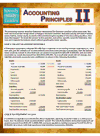
Accounting Principles 2 PDF
Preview Accounting Principles 2
CASE C: PROVIDE SERVICES ON ACCOUNT CASE D: PAY EXPENSES Expenses are the outflows and obligations that arise from producing goods and services. Imagine that Edelweiss paid $3,000 for expenses. This transaction reduces cash and income (i.e., retained earnings), as shown in the Case D illustration. IN GENERAL There are countless transactions, and each can be described by its impact on assets, liabilities, and equity. Importantly, no transaction will upset the balance of the accounting equation. TERMS In day-to-day conversation, some terms are used casually and without precision. Words may incorrectly be regarded as synonymous. Such is the case for the words “income” and “revenue.” However, each term has a very precise meaning. Revenues are enhancements resulting from providing goods and services to customers. Conversely, expenses can generally be regarded as costs of doing business. This gives rise to another accounting equation: Revenues - Expenses = Income Revenue is the “top line” amount corresponding to the total benefits generated from business activity. Income is the “bottom line” amount that results after deducting expenses from revenue. In some countries, revenue is also referred to as “turnover.” The Four Core Financial Statements One’s future will undoubtedly be marked by numerous decisions about investing money in the capital stock of some corporation. Another option that will present itself is to lend money to a company, either directly, or by buying that company’s debt instruments known as “bonds.” Stocks and bonds are two of the most prevalent financial instruments of the modern global economy. The financial press and television devote seemingly endless coverage to headline events pertaining to large public corporations. Public companies are those with securities that are readily available for purchase/sale through organized stock markets. Many more companies are private, meaning their stock and debt is in the hands of a narrow group of investors and banks. If one is contemplating an investment in a public or private entity, there is certain information that will logically be sought to guide the decision process. What types of information is desired? What does one want to know about the companies in which one is considering an investment? If one were to prepare a list of questions for the company’s management, what subjects would be included? Whether this challenge is posed to a sophisticated investor or to a new business student, the listing almost always includes the same basic components. What are the corporate assets? Where does the company operate? What are the key products? How much income is being generated? Does the company pay dividends? What is the corporate policy on ethics and environmental responsibility? Many such topics are noted within the illustrated “thought cloud.” Some of these topics are financial in nature (noted in blue). Other topics are of more general interest and cannot be communicated in strict mathematical terms (noted in red). FINANCIAL STATEMENTS Financial accounting seeks to directly report information for the topics noted in blue. Additional supplemental disclosures frequently provide insight about subjects such as those noted in red. One would also need to gain additional information by reviewing corporate websites (many have separate sections devoted to their investors), filings with securities regulators, financial journals and magazines, and other such sources. Most companies will have annual meetings for shareholders and host webcasts every three months (quarterly). These events are very valuable in allowing investors and creditors to make informed decisions about the company, as well as providing a forum for direct questioning of management. One might even call a company and seek “special insight” about emerging trends and developments. Be aware, however, that the company will likely not be able to respond in a meaningful way. Securities laws have very strict rules and penalties that are meant to limit selective or unique disclosures to any one investor or group. It is amusing, but rarely helpful, to review “message boards” where people anonymously post their opinions about a company. Company specific reports are often prepared by financial statement analysts. These reports may contain valuable and thought provoking insights but are not always objective. Financial accounting information is conveyed through a standardized set of reports. The balance sheet has already been introduced. The other financial statements are the income statement, statement of retained earnings, and statement of cash flows. There are many rules that govern the form and content of each financial statement. At the same time, those rules are not so rigid as to preclude variations in the exact structure or layout. For instance, the earlier illustration for Edelweiss was first presented as a “horizontal” layout of the balance sheet. The subsequent Edelweiss examples were representative of “vertical” balance sheet arrangements. Each approach is equally acceptable.
